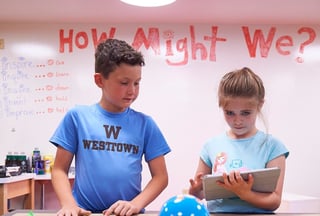 Empathy and action are at the heart of Quaker education. These attributes are also central to design thinking (DT), where students are asked to discover and understand needs, and then collaborate to meet them. They are asked to empathize, to interview, to dig deeper, and to ask Why? or How Might We?
Empathy and action are at the heart of Quaker education. These attributes are also central to design thinking (DT), where students are asked to discover and understand needs, and then collaborate to meet them. They are asked to empathize, to interview, to dig deeper, and to ask Why? or How Might We?
Developed by Tim Brown of Stanford University, design thinking is both a mindset and a process. We begin by modeling the mindsets of design thinking: curiosity, creative confidence, fail up/fail fast/fail often, just make it, embrace ambiguity,empathize, iterate, and optimism, or a “Yes, And” attitude. As students engage in design thinking, they develop these mindsets.
Once we truly empathize with a person, only then canwe start to brainstorm and create out-of-the-box solutions that resolve their needs. A famous example of DT involves Doug Dietz, an engineer who designed MRI machines. Dietz received awards for his machines because of their efficiency, however, when he went to see them in action at a children's hospital it became apparent that the the patients were afraid of the machines. Dietz knew he had to dig deeper and come up with a better solution. Using DT principles at Stanford University’s the d.School, he interviewed patients, parents, nurses, MRI technicians, and museum docents. He decided to reframe the experience for the young patients. Dietz worked to have scenes painted around the machines and brought in museum docents to help train the MRI techs and nurses on the different "scripts" to share with the children. When the redesign was finished, patients could walk the plank on a pirate ship or experience an underwater adventure, capturing imaginations and settling fears. By using the DT process, Dietz was able to improve his creation, while simultaneously transforming the experience of patients into a more positive one.
Empathy and action allow us to improve upon a wide range of situations, from daily discomforts to complex problems. We can do this by being creative, innovative thinkers. Children approach problem solving differently than adults, so it is especially important to help them develop these skills while they are young. In order to become big problem solvers, children need to develop mindsets and habits of empathy, inquiry, brainstorming, and inventive thinking. They also need to prototype and get feedback, so they can feel confident with improving upon their ideas. They need to fail often and take risks in order to learn to think originally. We need to help students expand beyond the “one right answer” way of thinking to counter fixed mindsets and social norms. Design thinking encourages a growth mindset, and cultivates this open-ended thinking, while encouraging empathy as a problem-solving skill.
To prepare for design thinking we encourage problem finding, practice interviewing and asking “Why?” multiple times. We brainstorm without judgement and build upon it, until we have multiple ideas. From there we organize, group and categorize our ideas. These ideas are then combined and built upon in order to create a prototype. Prototypes are created quickly so that we can get feedback and make changes.
Westtown is in its third year of using design thinking. Students have created solutions to a wide range of problems from:
- Finding ways to redesign the migration experience of a refugee;
- Working with a local homeless shelter to work through some of their challenges;
- Creating a new habitat for the class guinea pigs in second grade;
- Creating an “outside the box” lunchbox
- Solving a problem found on campus
- Designing traps in kindergarten to catch run-away gingerbread babies
As we continue to use design thinking with students, I am confident that students who have had this experience will be future innovators, equipped to solve the problems of tomorrow. They will move beyond “out of the box” thinking, and instead discover, there is no box.



